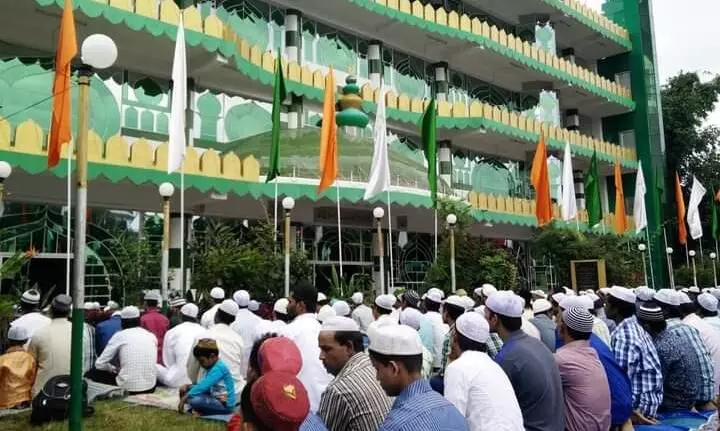
Source: N I Laskar
Nurul Islam Laskar
Guwahati, July 10: Muslims all over the world have two major festivals, Eid ul Fitr and Eid ul Azha. While Eid ul Fitr is celebrated on conclusion of one month of fasting during the holy month of Ramzan, Eid ul Azha is celebrated two months and ten days after Eid ul Fitr. While Eid ul Fitr encompasses a lot of merriment and camaraderie, Eid ul Azha upholds the spirit of sacrifice, where an animal is slaughtered as a symbol, and its meat shared among the poor, needy, and one's own kith and kin. In the Islamic lunar calendar, Eid ul Azha falls on the tenth day of the month Zil Hajj and lasts for four days.
Though universally known as Eid ul Azha, in India many people refer to this festival as Bakrid or Qurbani Eid. The Arabic word Eid means festival, celebration, feast day, or holiday. The word Azha is synonymous in meaning sacrifice (animal sacrifice), offering or oblation. In India, a bakri is a goat, and because goats are commonly sacrificed in vast parts of India during this festival, the masses here have named the festival Bakrid. Qurbani is an Urdu word which also means sacrifice, and hence Qurbani Eid i.e. Eid of sacrifice.
Ibrahim (pbh) is one among the important prophets whose names are mentioned in the Holy Quran. One of the main trials of Ibrahim's life was to face the command of Allah by killing his own son. According to what is narrated in the Quran, Ibrahim kept having nightmares that he was sacrificing his son Ismail (pbh). Ibrahim knew that this was command from Allah and he told his son, "Oh son, I keep dreaming that I am slaughtering you," and Ismail replied "Father do what you are ordained to do." Ibrahim prepared to submit to the will of Allah and got ready to slaughter his son as an act of faith and obedience to Allah. During the preparation, the devil (Shaytaan) tempted Ibrahim and his family by trying to dissuade them from carrying out Allah's commandment, and Ibrahim drove devil away by throwing pebbles at him. Acknowledging that Ibrahim was willing to sacrifice what is dear to him, his own son, Allah the Almighty honoured both Ibrahim and Ismail. Angel Jibrail called Ibrahim, "O Ibrahim, you have fulfilled the revelations." Instead, a lamb from heaven was offered by Jibrail to prophet Ibrahim to slaughter in place of Ismail. Muslims world over celebrate Eid ul Azha to commemorate both the devotion of Ibrahim and the survival of Ismail.
The tradition for Eid ul Azha involves slaughtering an animal and sharing the meat in three equal parts – for family, for relatives and friends and for poor people The idea is to make sure every Muslim gets to eat meat for a day or more.
Eid ul Azha prayer or namaz is normally offered in the open, at the Eidgah. Some people offer prayers at the masjid also. The Eid ul Azha prayer is performed any time after the sun completely rises, till it's midday. Eid prayers must be offered in congregation. Participation of women in the congregation varies from community to community, and from country to country. After the prayers and sermons get over, Muslims exchange greetings with one another, usually embracing each other with the words, "Eid Mubarak." The young ones in the family receive gifts from their elders. This gift is called "Eidi" in the Indian sub-continent. Families visit the houses of one another. Many Muslims also take this opportunity to invite their friends, neighbours, co-workers and classmates to their Eid festivities to better acquaint them about Islam and Muslim culture. In many places in India, Eid Mehfils and mushairas are organised where non-Muslims also participate with great enthusiasm.
I was born and brought up in Shillong when this hill city was the capital of undivided Assam. I have vivid memories of famous personalities such as Fakhruddin Ali Ahmed, who later became the President of India, and Air Marshal IH Latif, who subsequently took over as the chief of Indian Air Force, taking part in the Eid congregational prayer at the Laban Eidgah, where the famous glass masjid of Shillong has come up subsequently. After the Eid prayers, we used to visit the kabristan (burial ground) to offer prayers for the peace of all departed souls and thereafter, go all around the town distributing qurbani meat.
No treatise on Eid ul Azha will be complete without the mention of Hajj, the annual pilgrimage that an affluent Muslim has to perform at least once in lifetime. Both Eid ul Azha and Hajj are held almost simultaneously while the rituals for Hajj are elaborate and many, some of which are quite stringent. While Eid can be celebrated anywhere in the world, Hajj can be performed only in Saudi Arabia, keeping the Kaaba, the sacred black stone at the grand mosque in Makkah, at the centre of all rituals. Pilgrims also visit Mina and Jamarat where Ibrahim had taken his son Ismail for sacrifice. In a symbolic act of keeping the devil at bay, the pilgrims throw stones at three pillars situated at Jamarat. On an average, about 15 to 16 lakh Muslims from all over the world take part in the Hajj pilgrimage every year.
Like most other Muslim festivals, Eid ul Azha does not take place on the same date every year. The reason is simple. The Muslims don't follow the Gregorian calendar. They follow the Hijri calendar which is based on the lunar year. A lunar year is ten days shorter than the Gregorian calendar. Therefore, if Eid ul Azha is celebrated on 10th July this year, in all probability it will be celebrated on 31st May in the coming year.
Here's Eid Mubarak to all of you!
